- Open to students around the world.
- Start now, and complete at your own pace.
- Earn 2 or 3 transferable college credits.
- Register Now.
Unit: Al Bowlly
Al Bowlly

The Big Swoon
1899-1941
Al Bowlly, one of the most popular singers in Britain in the 1930’s, had quite the diverse background. His father was Greek, his mother was Lebanese, he was born in Mozambique, and he was raised in South Africa. His career started with dance bands in the 1920’s that toured Africa and Asia. He made his first recording in Berlin in 1927, singing Irving Berlin’s “Blue Skies.” Bowlly then relocated to London and sang with Fred Elizalde’s orchestra. Bowlly’s song “If I Had You” became one of the first recordings by an English jazz band to find popularity with American audiences.
Bowlly had significant success after joining Ray Noble’s recording band; he made recordings of a number of songs considered standards, including “The Very Thought of You” and “Love is the Sweetest Thing.”
He found some success performing in New York and again in London, but he died during the bombing of London in World War II. His last recording, “When That Man is Dead and Gone,” an anti-Hitler song, was made two weeks before his death.
Bowlly is remembered as a prolific recorder, singing on more than 1,100 recordings. He is also commonly considered the first “crooner,” a term for male singers who sang in a sentimental style that could be better realized after technological advances in microphones.
“The Very Thought of You”
Unit: Al Jolson
Al Jolson
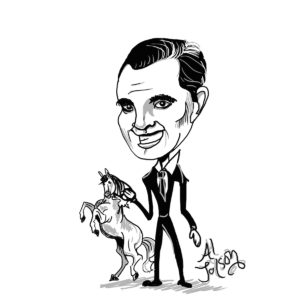
A Man of Firsts
1886-1950
Al Jolson was a man of “firsts.” Born in Lithuania, he immigrated to the United States with his parents when he was still a young child. His singing career began at the age of twelve when he and his brother entertained the troops during the Spanish-American War. Known for his extraordinary charisma and connection with the audience, it’s no surprise that his Broadway career spans almost 30 years. Jolson said, “A responsive audience is the best encouragement an actor can have.” Jolson was the first musical artist to sell more than 10 million records, and is best known for his appearance in one of the first “talkies,” called The Jazz Singer. He had more than 20 No. 1 hits and one of his signature tunes, called “Sonny Boy,” was the first recording in America to sell three million copies. He had his own show in 1947, and despite the fact that his competition included the likes of Frank Sinatra and Bing Crosby, Jolson was voted the Most Popular Male Vocalist in 1948. He was also the first Broadway performer to earn $10,000 per week and one of the first faces on television. He had a tremendous amount of energy on stage, is noted for performing with live horses in the 1925 show Big Boy, and was an amazing whistler as well. He could literally sound like a songbird that had flown into the theater and joined the performance.
Great whistling
“Let Me Sing and I’m Happy”
Unit: Art Tatum
Art Tatum

“The Crazed Chopin”: Founder of the Tatum
1909-1956
Art Tatum, the man was said, “There is no such thing as a wrong note,” was an amazing African-American jazz pianist whose technique impressed not only jazz musicians but also classically trained pianists. Both Sergei Rachmaninoff and Vladimir Horowitz claimed he was the greatest piano player in any style, and Gershwin was a huge fan as well. A French poet once called him “a crazed Chopin.” Tatum did not consider himself a classical pianist, but one of his most famous works is his own version of the “Humoresque” by Antonin Dvorak. Tatum was nearly blind, and learned to play almost entirely on his own by copying piano roll recordings that his mother played, and he did all of this by ear at the age of 3! Many jazz pianists since have tried to emulate his style and techniques with limited success. By the age of 6, he was playing music designed as duets, completely unaware that the music was written for two players. Some musicians believe that this helped Tatum developed his fast playing style. His first recording, “Tea for Two” would become his signature piece for life. Tatum’s influence was not limited to just piano players; legendary performers Coleman Hawkins (voice) and Charlie Parker (sax) both tried to translate his fast-moving melodic lines with their own instruments. Many of his harmonies and chord voicings were ahead of the time and would be adopted into Bebop many years later. In what may be the most unique honor ever, an MIT student recently coined a term that is now used in the field of computational musicology called “The Tatum.” The term refers to the smallest time unit that can be perceived in music.
“Yesterdays”
Art Tatum plays Dvorak
Unit: Bessie Smith
Bessie Smith
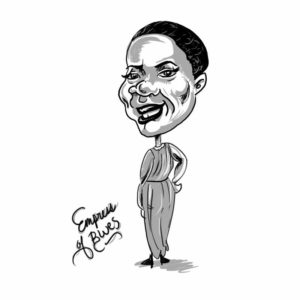
Empress of the Blues
1894-1937
Bessie Smith, one of seven children, was orphaned at the age of 7. From then on, she supported herself by singing and dancing on street corners. As a young teenager, she started working with Ma Rainey, one of first professional blues musicians, and sang for her Rabbit Foots Minstrels tent show. She had a powerful voice that could project throughout a tent. From there, Smith sang in cabarets, other touring minstrel shows, and the 81 Theatre in Atlanta.
Smith started recording in 1923 when a representative of the Columbia Phonograph Company happened to hear about her. Columbia was beginning to produce “race records” (records of African Americans performing blues, jazz, and gospel), and her recordings were very successful. She was the best-selling black artist of her time, and she sang to large audiences throughout the northern and southern United States, to both black and white concertgoers. She starred in the 1929 film St. Louis Blues, named after her 1925 hit song.
The Great Depression hit, Smith’s singing went out of style, and alcoholism made her unreliable, which hurt her career. Her last recording, marketed towards the growing jazz audience in Europe, was made in 1933, featuring Jack Teagarden and Benny Goodman. She was again performing regularly in 1936, but died in 1937 from injuries sustained in a car accident.
Bessie Smith had a low voice and relatively narrow range, but sang with attitude, feeling, soul, and bluesy inflections. She had clear intonation and could sing with a variety of expression. Later singers like Janis Joplin and Aretha Franklin would emulate her vocal styles, and in the late 20th century, the Grammy Hall of Fame, Rock and Roll Hall of Fame, and the Library of Congress National Recording Preservation Board recognized her music and legacy.
“St. Louis Blues”
https://youtu.be/jNWs0LsimFs
Unit: Billie Holiday
Billie Holiday
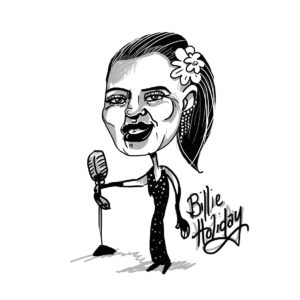
Lady Day; “It ain’t the blues … I don’t know what it is, but you got to hear her.”
1915-1959
Even though Billie Holiday’s life was filled with hardship, she managed to become one of the greatest voices in all of jazz. Named Eleanora Fagan at birth, her mother Sadie was a teenager, and her father, Clarence Holiday (a successful jazz musician who played with Fletcher Henderson) was absent in their lives. “I never had a chance to play with dolls like other kids,” Holiday said. “I started working when I was 6 years old.” At times, both she and her mother resorted to prostitution.
As a child, Holiday was confined to the House of Good Shepherd for Colored Girls, where she had been placed for truancy and for being a victim of statutory rape. Music brought her comfort in her difficult life, and she loved to sing along to recordings of Bessie Smith and Louis Armstrong. As a teenager, she found work singing in the clubs, speakeasies, and brothels of New York City. She would move from table to table, improvising a different melody on each chorus. With her strong personality, she earned the nickname “Lady,” and began calling herself “Billie” after the actress Billie Dove.
In 1935, she appeared on film with Duke Ellington in Rhapsody in Black and sang on her first of more than 100 recordings. She sang like a jazz musician, singing behind the beat, recomposing melodies, and adding all sorts of colors and inflections. She would often hold part of a phrase and catch up with the rest of it in the next few beats. As she became more popular, she worked with Count Basie, Artie Shaw, and Louis Armstrong.
She faced significant racism throughout her career. In the North, she was told not to mingle with white audiences. In the South, hotels and restaurants refused her service. She was also told to wear lighter or darker make-up, depending on the skin color of her accompanying musicians, to more closely resemble their skin color. The 1940’s and ‘50s saw Holiday battle heroin addiction and alcoholism, and serving time in prison for possession. She was still successfully performing, albeit with a voice that grew rougher from her lifestyle. She performed for the last time in New York City in May 1959, and died in a hospital two months later from her addictions.
Decades after her death, she is still considered among of the best (if not the best) jazz vocalists of all times, with a voice uniquely her own. “If I’m going to sing like someone else, then I don’t need to sing at all.” She was inducted into the Rock and Roll Hall of Fame in 2000.
“Summertime”
“The Very Thought of You”
Unit: Bing Crosby
Bing Crosby
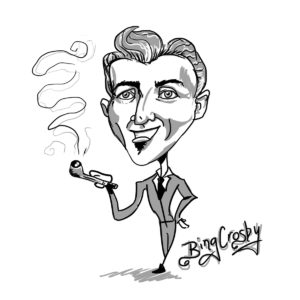
The Old Groaner
1903-1977
Harry Lillis Crosby, known as “Bing” (a nickname taken from one of his favorite comic strips) planned on being a lawyer. However, he dropped out of Gonzaga University during his senior year to pursue a music career.
As a child growing up in Washington, Crosby played drums and sang with smaller jazz groups. He moved to Los Angeles and formed a duo with friend Al Rinker: Two Boys and a Piano, which became a popular Vaudeville act on the West Coast. Crosby became one of the most successful singers of his era through his presence in a variety of formats (radio, television, film, recordings), singing popular tunes as a crooner with an inviting, conversational, smooth, and relaxed style. While previous singers sang at you, Crosby sang to you, and future singers emulated his style. And while he didn’t have the look of the typical handsome lead, audiences loved his calm, charming demeanor.
Beyond his singing style, Crosby made significant impacts in popular culture. His films with Bob Hope helped establish the genre of the buddy picture. He joked about Hope, “There is nothing in the world I wouldn’t do for Hope, and there is nothing he wouldn’t do for me… We spend our lives doing nothing for each other.” He starred in nearly 50 films and it is estimated his recordings sold at least 300 million copies. He helped pioneer the use of magnetic tape in the recording industry and his insistence in recording his radio shows instead of live broadcasts helped make recorded radio broadcasts standard. Decades after his death, he is still known for his Christmas specials and songs, particularly his performance of Irving Berlin’s “White Christmas” (the best-selling single of all time) and his duet of “The Little Drummer Boy” with David Bowie.
“White Christmas”
https://youtu.be/GJSUT8Inl14
“Peace on Earth/Little Drummer Boy”
https://youtu.be/ADbJLo4x-tk
Unit: Bix Beiderbecke
Bix Beiderbecke

Played melodies that no one else had thought of
1903-1931
Beiderbecke is remembered for his piano and trumpet/cornet playing. Most jazz trumpet players cite one of two main influences: the hot, flashy Louis Armstrong or the cool, thoughtful Bix Beiderbecke.
The Beiderbecke family was Midwestern upper-middle class. The parents weren’t professional musicians, but music was often heard in the home. They sent him to study at the Lake Forest Academy. While his family disapproved of jazz, the school was near a train station, and the young Beiderbecke spent his nights taking the train to Chicago to hear Bessie Smith, Ethel Waters, and Louis Armstrong. School absences and drinking eventually got him kicked out of school, and he moved to Chicago to pursue a career in music.
In 1924, he played with the Wolverines; his playing elevated them to one of the best white jazz groups of the era. He later played with the bands of Jean Goldkette and Paul Whiteman. Unfortunately, the combinations of hectic touring schedules and Beiderbecke’s alcoholism took a toll on his health, and he died at the age of 28.
Beiderbecke’s solo piano playing and compositions are known for being harmonically rich and complex, incorporating whole tone scales and advanced harmonic ideas. As a cornet player, he played in ensemble settings and needed to fit within a more traditional style, but this made him play in a cool, restrained, thoughtful manner, which, along with his unique tone, set him apart from other cornet and trumpet players. When discussing jazz, he said, “One of the things I like about jazz, kid, is I don’t know what’s going to happen next. Do you?”
“In a Mist”
“Singing the Blues”
Unit: Boswell Sisters
Boswell Sisters
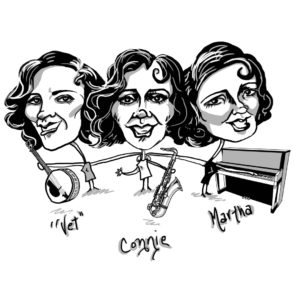
Helvetia “Vet” Boswell
1911-1988
Connee Boswell
1907-1976
Martha Boswell
1905-1958
The Boswell Sisters were raised in New Orleans with a very musical upbringing. Their father had performed in Vaudeville and the family attended many live performances in a wide variety of styles; the sisters were classically trained, but they also saw the best black musicians in town and immersed themselves in jazz, blues, and Southern gospel. The sisters learned how to play numerous instruments and began performing as “The Boswell Sisters” in the early 1920’s. They sang together with tight-knit harmonies and accompanied themselves: Martha played piano, Helvetia played violin, guitar, and banjo, and Connie played cello, saxophone, trombone, and guitar.
The sisters performed at Vaudeville venues and, after some successful recordings, relocated to New York. They toured and appeared on radio, film, and record. Their New York recordings featured top jazz musicians, including legendary performers Joe Venuti and Eddie Lang; the sisters, Connee in particular, continued to arrange the music.
In 1936, Martha and Helvetia retired from show business to focus on their families. Connee, despite needing a wheelchair since childhood, continued her music career as a successful soloist through the 1950’s. She would perform with Bing Crosby and influence future singers, including Ella Fitzgerald.
“Heebie Jeebies”
“The Object of My Affection”
Unit: Charlie Parker
Charlie Parker
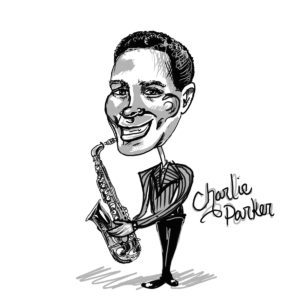
Creating Art Without Boundaries
1920-1955
The music and influence of Charlie Parker can be summed up in his own words: “There is no boundary line to art.” Charlie Parker is one of the primary founders of modern jazz, including the Bebop.
He explored the boundaries of melody, rhythm, and harmony on his saxophone and in his compositions. His motto could be said to be learn, practice, and forget. He said, “You’ve got to learn your instrument. Then you practice, practice, practice. And then when you finally get up there on the bandstand, forget all that and just wail.” It was during those times of forgetting up on stage that the music of Charlie Parker was born.
Parker didn’t start playing the saxophone until age 11. He was born and raised in Kansas City, so he was influenced by the music of Count Basie and Bennie Moten at an early age. Parker started performing with various groups while holding several other jobs. One of the jobs was as a busboy making $9 per week at a restaurant where he heard the music of Art Tatum. Later he would play with Earl Hines, and collaborated with Dizzy Gillespie, Thelonious Monk, and learned from Maury Deutsch.
Parker brought an intellectual element to his jazz. Many of his contemporaries of the time saw the traditional Big Band music as too cautious and restrictive. They didn’t feel it reflected the experience of urban society. Bebop was born out of the search for music that reflected that aspect of life, and according to Parker, “If you don’t live it, it won’t come out of your horn.” His music spoke to the difficulties and frustrations of urban life during those times. This music features asymmetrical rhythms, long complex melody lines, and new chords. Unfortunately, his lack of boundaries also included portions of his personal life, and drug and alcohol abuse cut short his life at age 34.
“Hot House”
https://www.youtube.com/watch?v=NcTrx0hL1ag
Parker playing with Coleman Hawkins
https://youtu.be/P-ZoZ3BeQ2U
Unit: Cliff Edwards
Cliff Edwards
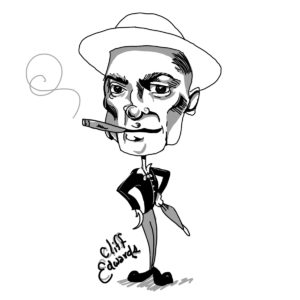
Ukulele Ike, the Voice of Jiminy Cricket
1895-1971
Cliff Edward’s first recording was as a kazoo player. Nearly 20 years later, his voice was immortalized as the voice of Jiminy Cricket in Disney’s 1940 film Pinocchio, singing “Give a Little Whistle” and “When You Wish Upon a Star.”
Edwards began performing as a teenager, playing in movie houses, saloons—and as a newspaper boy, where he performed to attract attention. He learned how to play the ukulele and was nicknamed “Ukulele Ike.” After the 1915 Panama Pacific International Exposition in San Francisco, the instrument became very popular, and he was among the most well-known ukulele players of the time. For the next ten years he was a Broadway, Vaudeville, and recording success, introducing the songs “Fascinatin’ Rhythm” and “Singin’ in the Rain.” He was also one of the first recorded singers to use vocables, or wordless syllables, similar to what would later be called “scat” in jazz.
After the 1920’s, Edwards’ career suffered; the ukulele went out of style, he suffered an unsuccessful attempt at a film career, and he struggled with finances and alcohol and morphine abuse. However, he still found work in film, Vaudeville, radio, and recording. In 1939 he had a small role in Gone With the Wind, and the next year he had significant success as the voice of Jiminy Cricket in Pinocchio. His last major hits were academy-award winning songs from the film.
“When You Wish Upon a Star”
“Singin’ in the Rain”
Unit: Earl Hines
Earl Hines
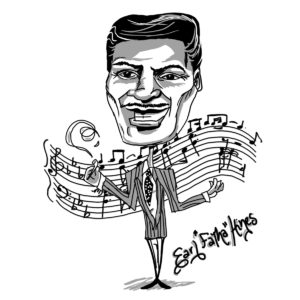
Fatha: The Father of Modern Jazz Piano
1903-1983
Earl Hines was a legendary jazz pianist. He had two suggestions that pertained to life and performance; “You may have holes in your shoes, but don’t let the people out front know it. Shine the top,” and, “I always challenge myself. I get out in deep water and I always try to get back. The audience never knows, but that’s when I smile the most, when I show the most ivory.” These statements were reflected in his style, which was so unique it was hard to imitate. It featured complex rhythms and melodies that sound like a trumpet.
Hines grew up in a musical family. His father was a cornetist and his stepmother played the organ at church. He originally intended to follow in his father’s footsteps, but decided that blowing on a horn hurt his ears, so he took up the piano instead. He started piano at age 9 and after three years of traditional lessons he shifted his emphasis to jazz, and by 15 he was leading his own trio. Hines describes jazz as the trunk of a tree. “After the tree has grown, many branches have spread out. They’re all with different leaves and they all look beautiful. But at the end of the season, they fold back up and it’s still the tree trunk.”
Hines’ career involved both solo work and a partnership with Louis Armstrong. Believing he had a photographic memory for chords, he said, “I don’t think when I play . . . when I’m playing the right chords appear in my mind like photographs long before I get to them.” Hines is known as the “Father of Modern Jazz Piano” and in fact his nickname was “Fatha.”
Link: http://www.newworldencyclopedia.org/entry/Earl_Hines
Hines explains his influences and technique
https://www.youtube.com/watch?v=UyXtW700vQ8
“Boogie Woogie on St. Louis Blues”
Unit: Eddie Cantor
Eddie Cantor

Banjo Eyes, The Apostle of Pep
1892-1964
Eddie Cantor was born in New York City to Russian immigrants. From the age of 2, he was raised by his grandmother, who didn’t always know what to do with the energetic kid. He started signing on street corners and left school at 13; a few years later Cantor performed in his first Vaudeville show.
After touring with Vaudeville acts, he found better work with Florenz Ziegfeld’s Follies and starred in Broadway revues (shows that combined music, dance, and sketches) and films. He reached stardom after his performance in the 1930 screen musical Whoopee!
Cantor’s performance often included him in blackface, the practice of white performers trying to look black, or black performers exaggerating the darkness of their skin. It was not until the end of the 1930’s that widespread public opinion recognized blackface as racist.
Cantor’s nicknames “Banjo Eyes” and “The Apostle of Pep” came from his stage presence. He had large eyes and used exaggerated expression with them, and he jumped across the stage during performances. Stylistically, Cantor had a high-pitched, whiny voice; beyond standing out, it could be heard throughout an auditorium. Despite his frenetic performances, Cantor said, “Slow down and enjoy life. It’s not only the scenery you miss by going too fast—you also miss the sense of where you are going and why.”
Cantor is especially remembered as a philanthropist. He named and helped found “The March of Dimes,” first promoting it in 1938 and encouraging people to send dimes to President Roosevelt, the most prominent victim of polio at the time.
“Yes Sir, That’s My Baby”
Unit: Eddie Lang
Eddie Lang
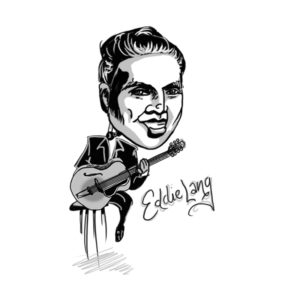
Father of Jazz Guitar
1902-1933
Anyone who plays jazz guitar can thank Eddie Lang; he was the first guitarist to play as a soloist, and was an influential factor in the guitar replacing the banjo in jazz ensembles.
Lang, originally named Salvatore Masso, was born in Philadelphia. He took 11 years of violin lessons, and his father taught him how to play the guitar. He and Joe Venuti, a classmate from Philadelphia, enjoyed success, playing in Atlantic City, New Jersey, and New York. Their guitar and violin duet recordings from 1926-28 are especially important to jazz guitarists and violinists. They also performed and recorded with the Dorsey Brothers, Frankie Trumbauer, and Paul Whiteman. Lang also recorded some blues records with Lonnie Johnson; they weren’t successful when he recorded as “Eddie Lang,” but when he recorded with the name “Blind Willie Dunn,” they sold well with blues audiences.
The sound of the acoustic guitar worked very well with recording technology during his career, and audiences liked his solos (usually played on a single string) and his accompanying style: chords interspersed with shorter melodies.
In the 1930’s, Lang played on the first recording of “Georgia On My Mind” and accompanied Bing Crosby after they both left Paul Whiteman’s band. He died unexpectedly at the age of 30 from complications from a tonsillectomy.
“Dinah”
https://www.youtube.com/watch?v=zeM-uvcIQqI
“Blue Room”
https://youtu.be/rFaBRZco8pI?list=PLAE5BC8896F75279F
Unit: Errol Garner
Eroll Garner
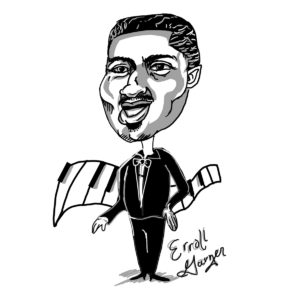
Among the most distinctive of all pianists
1923-1977
Garner was born in Pittsburgh in 1923 and began playing piano at the age of 3. He was a self-taught player who played entirely by ear. He never learned how to read music, but had an incredible memory of songs he had learned. Before he was a teenager, he performed on riverboats; in his twenties he played on Charlie Parker’s Cool Blues recordings.
He was influenced by Fats Waller’s rhythmic stride piano playing and is often compared to Art Tatum (another pianist from the same era considered among the best jazz pianists of all time). Both Tatum and Garner attacked the piano when playing, but Tatum’s playing was swingier, while Garner’s was funkier. Garner used a style of playing still common today called “locked hands,” where hands move up and down in the same general position. But he also played in a style all his own: his left hand kept the beat like a rhythm guitar while his right hand played slightly behind the beat.
In addition to his unique style, he was quite the showman. His trademark grunt could be heard in concert and on recordings, and was fun to watch. He was especially short (5’2), and would play this up in performance and on television, asking hosts of shows to lend him phone books to sit on to reach the piano. That, combined with his sharp attire and glowing personality on television, made him stand out among other jazz pianists. “I always play what I feel. I always feel like me, but I’m a different me every day. I get ideas from everything. A big color, the sound of water and wind, or a flash of something cool. Playing is like life. Either you feel it or you don’t.”
Garner was a prolific recorder, sometimes recording three albums in a single day (all on the first take, and from memory). His song “Misty” is a jazz standard, and his 1958 live album Concert By the Sea is one of the most commercially successful and critically acclaimed jazz albums.
“Misty”
Unit: Ethel Merman
Ethel Merman
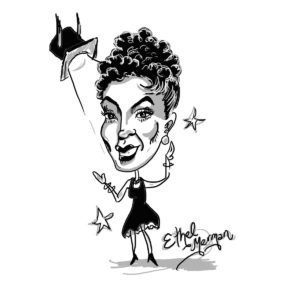
The Power of a Voice
1908-1984
Ethel Merman said, “I can never remember being afraid of an audience. If the audience could do better they’d be up here on stage and I’d be out there watching them.” Her mother said she could hold a tune when she was just a toddler; and Merman herself said she could “hold a note as long as the Chase National Bank.” Merman’s parents were an accountant and a school teacher, so they were very concerned about their daughter’s interest in show business. They encouraged their daughter to learn a valuable skill, so she became a stenographer, but it wasn’t long before she was making enough money singing in nightclubs that she could quit her job and pursue singing as a career.
Merman was known for her very powerful voice. During this time, stage singers performed without microphones so she had a tremendous advantage over the other singers. She is associated with many well-known songs of the day, but her signature song was “There’s No Business Like Show Business.”
Merman’s greatest success was on the stage. She retired from Broadway in 1970 and looked to television and movies, but was not able to achieve the same level of success in the movie world that she had in live theater.
“Earful of Music”
“There’s No Business Like Show Business”
Unit: Ethel Waters
Ethel Waters
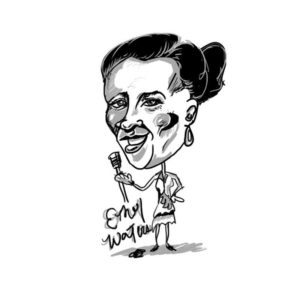
Sweet Mama Stringbean
1896-1977
Ethel Water’s early life was extremely challenging, but compared to many other legendary performers, she went on to lead a happy, successful, long life. She was born as a result of her mother Louise being raped as a teenager; her father, a pianist, had no role in Ethel’s life. They lived in poverty, and Waters was 12 years old when she married for the first time; at age 13, she began working as a chambermaid and sang at a local nightclub. She also sang and danced in the streets to earn money.
Waters started dancing with a Vaudeville troop and became known as Sweet Mama Stringbean; she was exceptionally tall and skinny. She danced well, but after a car accident limited her dancing abilities, she focused on singing. She had a unique voice that combined elements of “proper” Broadway singing and “raw” blues singing. She scooped into and dropped off of pitches and sang around the beat, but she also sang with a clear sense of diction and pitch.
Waters was nothing short of groundbreaking: the first woman to perform “St. Louis Blues;” the first black Vaudeville and nightclub performer to transition to white theaters and audiences; the first black performer to share a Broadway stage with a predominately white cast; the second African-American to be nominated for an Academy Award, and the first African-American to be nominated for an Emmy.
Waters continued to perform in concert, on Broadway, and on the radio, and towards the end of her career, she toured with evangelist Billy Graham, singing gospel songs. “His Eye Is on the Sparrow” was one of her favorites. Looking back on her upbringing, she said, “Mom never quit on me. My only regret is that she didn’t live long enough to share some of the money and comforts my work in show business has brought me.”
Ethel Water’s pivotal recordings include “Am I Blue?” “Stormy Weather (Keeps Rainin’ All the Time),” and “Dinah.”
“Stormy Weather”
“His Eye Is on the Sparrow”
https://youtu.be/9wETLPYOMMY
Unit: Fanny Brice
Fanny Brice

“The Girl You Can’t Forget”
1891-1951
Like many performers of her time, Brice did it all; singer, actress, comedian, and radio personality. Her father was a bartender and her mother worked in a factory. Marital problems caused the family to separate, and as a result Brice ended up in New York, settling in Brooklyn. She got her start in a talent contest when she was 13 and won first prize for the song “When You Know You’re Not Forgotten by the Girl You Can’t Forget.” She left school to pursue a career in the music industry, but she failed in her first attempts. She ended up singing in a burlesque house, which was the least competitive performance venue at the time, and was discovered there by Ziegfeld who made her a star in his famous Ziegfeld Follies that same year.
Brice relied on the response of the audience rather than her directors. She said, “Your audience gives you everything you need. They tell you. There is no director who can direct you like an audience.” She experienced the typical amount of upheaval in her personal life that often seems to follow performers. She was married three times. Her second husband, also the father of her two children, served three years in a penitentiary and disappeared when he was released. Her successful career earned her the Grammy Hall of Fame award for her hit single “My Man,” and a star on the Hollywood Walk of Fame. Thirteen years after her death she was portrayed by Barbara Streisand in Funny Girl, the hit musical about her life.
“It’s Gorgeous to be Graceful”
Brice as an opera diva
Unit: Fred Astaire
Fred Astaire
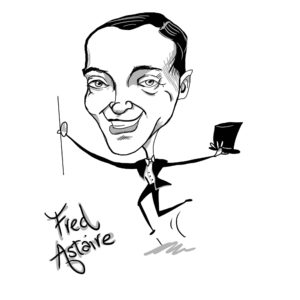
“Can’t act! Slightly bald! Can dance a little!”
1899-1987
Fred Astaire is one of the most famous entertainers of all time. Which is remarkable, since after his first screen test in 1933, the memo from the testing director of MGM said, “Can’t act! Slightly bald! Can dance a little!” This director could not have been more mistaken. Astaire began his career at the age of 5, performing with his sister alongside many other Vaudeville acts. His full career spanned 76 years. His most famous pairing was with Ginger Rogers, but he also worked with great composers like Irving Berlin, George Gershwin, and Cole Porter. If you watch Astaire dance, you may notice that when he had his arms outstretched he would often bend his two middle fingers towards his palm. It turns out he did this because he thought his hands were too big so he tried to disguise it in this way. The lesson here is that even the most successful of people can be insecure about something. In describing his own dancing, Astaire said, “I just put my feet in the air and move them around.” He also said that “dancing is a sweat job” and, “The higher up you go, the more mistakes you are allowed. Right at the top, if you make enough of them, it’s considered to be your style.”
The video for Lionel Ritchie’s song “Dancing on the Ceiling” includes the same camera shot that Astaire employed in the movie Royal Wedding. The technique makes it look as though Astaire was dancing around a room, literally, including up the walls and upside down, on the ceiling. This illusion is created by fixing the camera to the set and literally turning the room, and with it the camera, while he dances. If you watch “You’re All The World to Me” on YouTube you can see Astaire pause and set himself up at each point where he needs to move to the next surface as the room rotates around.
P.S. Astaire kept that memo over the fireplace of his Beverly Hill’s home.
Link: http://www.biography.com/people/fred-astaire-9190991
“You’re All the World to Me”
Unit: Helen Kane
Helen Kane
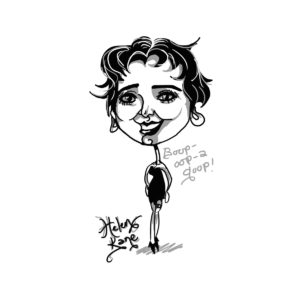
“Boop-boop-be-doop!”
1904-1966
Helen (nee Schroeder) Kane was born in the Bronx. As a teenager, she performed with the Marx Brothers and saw success with Vaudeville. She rose to stardom in 1928 with her recording of “I Wanna Be Loved By You,” where she added the phrase “Boop-boop-be-doop!” with a baby voice. It strongly resonated with the 1920’s flapper culture, and in some ways, epitomized her entire career. She provided the inspiration for the iconic cartoon Betty Boop.
While she was strongly associated with her catchphrase and the ensuing cartoon, she continued to enjoy a diverse showbiz career. She starred in the films Sweetie (1929), Paramount on Parade (1930) and Heads Up (1933), and the Broadway productions A Night in Spain (1927) and Shady Lady (1933).
Kane’s career waned during the Great Depression, but she returned to film in 1950, singing dubbed vocals over Debbie Reynolds to “I Wanna Be Loved by You.” She also performed live and appeared on The Ed Sullivan Show. She battled breast cancer in the 1950’s and ‘60s before passing away at the age of 62.
“I Wanna Be Loved by You”
Unit: Helen Morgan
Helen Morgan
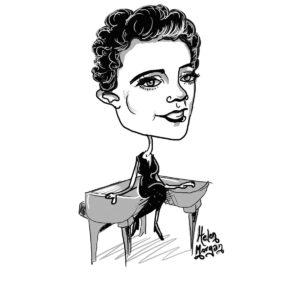
A Quintessential Torch Singer
1900-1941
A native of Illinois, Helen Morgan started her career singing in Chicago clubs and winning beauty pageants. Prohibition-era mobsters took an interest in her and financed her own clubs, which she operated and performed in. She also studied vocal performance in New York at the Metropolitan Opera.
School, and rotated between singing in New York and Chicago speakeasies and playing smaller roles on Broadway.
As her performance trademark, Morgan sang while sitting on the piano. This started from necessity; there wasn’t enough room in the packed club for her to stand. But the crowds loved it, so she continued. She was a “torch singer,” singing sad songs about lost or unrequited love, but her style and voice—classically trained, not as low, and comparatively thin—was starkly different from other torch singers of the time. It sounded vulnerable, especially as she mournfully sang from the top of a piano, and audiences empathized.
Her greatest success came in 1929 with the original Broadway production of Show Boat; in it, she sings the torch song “Can’t Help Lovin’ Dat Man.” She also starred in the 1936 film version of the musical, her last film appearance.
Alcoholism took a toll on Morgan; she collapsed on stage in 1941 and died from liver damage in Chicago that same year.
“Can’t Help Lovin’ Dat Man”
https://youtu.be/vakcYAKtqas
Unit: Jack Teagarden
Jack Teagarden
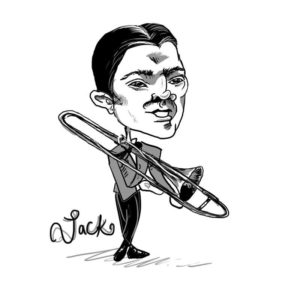
Big T, Father of Jazz Trombone
1905-1964
Jack Teagarden was born in Texas; his mother gave him piano lessons at age 5, and he started playing trombone at age 10. By the time he was a teenager, he played professionally with local Southwest bands. He relocated to New York, and compared to other white musicians there, he was particularly skilled at playing the blues; he grew up with black people and heard spirituals, work songs, and the blues from an early age.
In New York, he played with Louis Armstrong and as part of Paul Whiteman’s band. He also had a short-lived after-hours gig with the Three T’s, playing with his brother Charlie and saxophonist Frankie Trumbauer. He started his own big band; musically, it was well regarded, but it bankrupted Teagarden in 1946. He joined Louis Armstrong’s All Stars in 1947, and from 1951 until his death, he led small music groups.
Teagarden taught himself how to play the trombone, resulting in a very unique style. He played in the higher register of the instrument, and his solos were detached from the beat. He was also accomplished as a jazz singer. He singing was simpler than his trombone playing, but it had a warm, laid-back, bluesy sound. He said about his music: “All that I’ve played, all that I’ve sung, I couldn’t have done any other way.”
Teagarden also appeared in the 1941 film Birth of the Blues and an episode of The Andy Griffith Show.
“Jeepers Creepers”
Unit: Jimmy Durante
Jimmy Durante
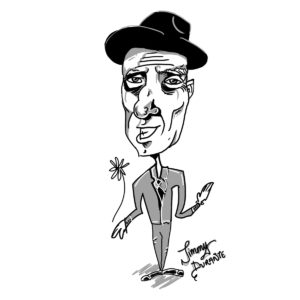
Schnozzola: The Best Nose
1893-1980
Like many performers of the ‘20s, Jimmy Durante did it all; played the piano, sang, did comedy and acting, and did them well into the 1970’s. He was best known for his stunning nose that was responsible for his famous nickname: Schnozzola. Durante dropped out of school in eighth grade to become a ragtime pianist. He soon joined a famous jazz band, and his habit of breaking into a song or joke in the middle of a song, followed by a musical response from the group, became his trademark. You can see this in the performance with Louis Armstrong by clicking on the video link below. His signature song, “Inka Dinka Doo” was actually composed by Durante himself.
Success in Vaudeville was followed by even greater success in radio during the 1940’s. His first radio appearance in 1933 as a stand-in for a regular star was such a hit that he was immediately offered his own show. Durante was also involved in television from the very beginning, including the NBC comedy variety show “The Big Show,” where he appeared with numerous stars including Fred Allen, Frankie Laine, Ethel Merman, and Danny Thomas. Thomas was the proud owner of a nose to rival Durante’s, so Durante made a standard routine out of accusing Thomas of stealing his nose. Durante also was involved in film; you may have heard his voice as the narrator of the famous Rankin-Bass Christmas special Frosty the Snowman. He did commercials for Kelloggs cornflakes and the Volkswagen Beetle, where he stated that the new Beetle had “plenty of breathing room . . .for da old schnozzola!” You may have heard him singing “As Time Goes By” while watching Sleepless in Seattle, and the same movie closes with his version of “Make Someone Happy.” Durante used to say, “Be kind to people on the way up—you’ll meet them again on your way down.” With typical wit, and in reflection of his early years when he would interrupt the performance to make jokes, he often said, “I hate music, especially when it’s played.” It wouldn’t be right to end this paragraph with anything other than his signature catch phrase “Ha-cha-cha-chaaaaaaa!”
Link: http://www.newworldencyclopedia.org/entry/Jimmy_Durante
“Old Time Man”
Unit: Joe Venuti
Joe Venuti
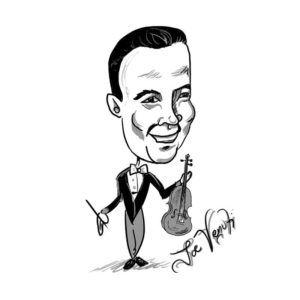
Father of Jazz Violin
1903-1978
Besides being known as the most important violinist in early jazz, Venuti is remembered as a practical joker. He once hired dozens of bass players to meet him at a busy New York street corner simply to see the chaos unfold; the number of musicians (and their large instruments) blocked traffic. He also enjoyed providing incorrect information on his background, resulting in different listings of his year of birth and country of origin. He was most likely born in 1903 and grew up in Philadelphia. He learned about music from his grandfather and studied violin, and he began collaborating with guitarist Eddie Lang.
Venuti moved to New York in 1925, where he and Lang were in high demand and played with the leading white jazz musicians of the late ‘20s and early ‘30s (a time of segregation), including Benny Goodman, Bing Crosby, and the Boswell sisters. The two recorded a number of influential violin and guitar duos; these would particularly inspire Django Reinhardt and Stephane Grappelli in Paris.
Lang suddenly died in 1934, and Venuti’s career slowed considerably. He led a somewhat successful big band until 1943 and then toured with small groups, but he was no longer a major figure and suffered from alcoholism. However, after a celebrated performance at the Newport Jazz Festival in 1968, he returned to prominence in the jazz world and recorded with important jazz figures in the last decade of his life.
Venuti played with a hot, swinging, virtuosic style and sometimes adjusted his bow so that it wrapped around the strings, allowing him to play chords with a wild sound. “If you’re going to make a mistake,” he said, “make it loud so everybody else sounds wrong.”
“Stringing the Blues”
“Dinah”
https://youtu.be/zeM-uvcIQqI
Unit: Judy Garland
Judy Garland
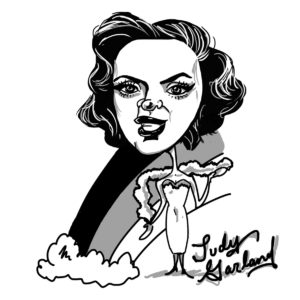
A Midwest Girl in an MGM Lot
1922-1969
Judy’s parents, Frank and Ethel Gumm, met in Superior, WI at the Parlor Theater. Her mother played piano, and her father was a singer and manager. Judy began her life as Frances Ethel Gumm and got her start in show business when she was only 2 years old, singing “Jingle Bells” on stage at her parent’s theater. She was so thrilled with the applause that she sang the song five times before her Dad carried her off the stage. Her family relocated to California while she was still a young girl, and Judy and her two sisters, Mary Jane (Suzy) and Dorothe Virginia (Jimmie), continued to find work in the theater. Judy said, “I was born at the age of 12 on an MGM lot,” which is when her name was changed to Judy Garland.
After a string of minor roles, Garland’s big break into show business came when she was cast for the leading role of Dorothy in the Wizard of Oz. About the role Garland said, “I’ve always taken The Wizard of Oz very seriously, you know. I believe in the idea of the rainbow. And I’ve spent my entire life trying to get over it.” Many famous song writers wrote songs with Judy in mind, among them Irving Berlin, Cole Porter, and Ira Gershwin.
After her success in the Wizard of Oz, she performed in numerous productions with a wide variety of stars. At that time, many stars were given both amphetamines and barbiturates to help them keep up their energy during rigorous performance schedules. Unfortunately, this practice led to a lifelong struggle with addiction that eventually caused her death. Throughout her life, Garland believed that one should “Always be a first-rate version of yourself, instead of a second-rate version of somebody else.”
Link: http://www.biography.com/people/judy-garland-9306838
“Somewhere Over the Rainbow”
https://www.youtube.com/watch?v=U016JWYUDdQ
“The Trolley Song”
https://youtu.be/hmx1L8G25q4
Unit: Louis Armstrong
Louis Armstrong
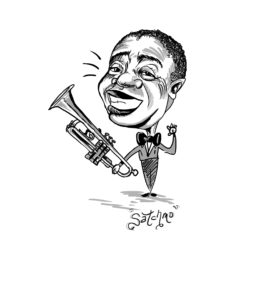
Taught the world to swing
1901-1971
Louis Armstrong, one of the most important figures in jazz, is still remembered decades after his death for songs like “Hello Dolly” and “What a Wonderful World.” Time magazine includes him among the most influential Americans of all time. But he came from humble beginnings.
Armstrong grew up in New Orleans and started working at a young age to help support his family, dropping out of school in fifth grade. His father deserted the family shortly after Louis’ birth, and his mother often had to resort to prostitution. His first music instruction came at the Colored Waif’s Home for Boys, where he was sentenced for firing a gun on New Year’s Eve as an 11-year-old. As he got older, he moved across the country, playing with the premier bands of New Orleans, Chicago, and New York City. He appeared on dozens of albums, included backing up Bessie Smith. He moved back to Chicago and recorded a huge number of albums with his own bands, Louis Armstrong and His Hot Five and Hot Seven. These records are some of the most important in early jazz history; they were improvised, with New Orleans musicians playing New Orleans-style music.
Armstrong continued to record and perform. In the 1950’s and ‘60s, he played all over the world, serving as an international ambassador of swing. In the last years of his life, he knocked the Beatles off the top of the pop charts with “Hello Dolly” (no jazz recording since has ever topped the charts) and recorded “What a Wonderful World,” a song inspired by his home in Queens. He said, “The memory of things gone is important to a jazz musician. Things like old folks singing in the moonlight in the back yard on a hot night or something said long ago.”
He played with a hot, flashy style and sang with a sound completely his own. He was nicknamed “Satchmo,” an abbreviation of Satchelmouth, for his large mouth.
“Hello Dolly”
“What a Wonderful World”
https://youtu.be/m5TwT69i1lU
Unit: Maurice Chevalier
Maurice Chevalier
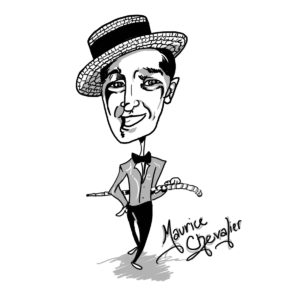
French actor, singer, entertainer
1888-1972
Maurice Chevalier was a French singer and actor. At age 11, he left school for a career as an electrician and then as an acrobat; after an injury, he focused on becoming a singer and actor and performed song-and-dance routines in French music halls and cafes. He served with the French Army during World War I and was captured. American and British soldiers in his prisoner of war camp taught him how to speak English, a skill that helped him find future success in the United States.
After World War I, Chevalier performed in music halls, silent films, and theater productions, and began working with Paramount Pictures in 1928. In his first Hollywood film, Innocents of Paris, he sang “Louise,” which would became his first hit in the United States and remained a popular song of his throughout his career. He moved back to France before World War II, and during the war, he performed in Germany in exchange for the release of French prisoners of war.
After World War II, Chevalier performed all over the world as a one-man show. He resumed his Hollywood career in the 1950’s and received an Academy Honorary Award in 1958; he also appeared on television as himself on the The Jack Benny Program and The Lucy-Desi Comedy Hour. In the last decades of his career he adopted the role of the distinguished, older French gentleman. About aging, he said, “The French are true romantics. They feel the only difference between a man of forty and one of seventy is thirty years of experience.” He gave his final performances in 1968. He died in 1972 at the age of 83. His last contribution to film was singing a song for the 1970 Disney film The Aristocats, and he is remembered for paving the way for international performers to find stardom in the United States.
“Louise”
“The Aristocats”
Unit: Nat "King" Cole
Nat “King” Cole
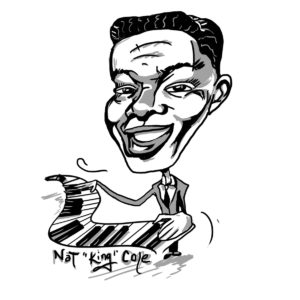
Unforgettable
1917-1965
Nathaniel Adams Coles is more widely known as Nat “King” Cole; the stage name most likely referenced the nursery rhyme Old King Cole. He was born in Alabama, and at the age of 4, his family moved to Chicago. His father was a pastor, and Cole sang with the choir and played organ by the age of 12. As a teenager, he dropped out of school to pursue a career as a jazz pianist.
Cole led The King Cole trio in the 1930’s and ‘40s. The trio often sang in unison, but the recordings of Nat singing as a soloist became hits. While he was an accomplished jazz pianist, he focused on singing, which is regarded as among the best of the era. His recordings sold widely among both black and white audiences; he was the first black jazz musician to host his own radio show. Regarding race, he said, “I may be helping to bring harmony between people through my music.” His voice had a soft, liquid sound, and his diction and rhythm were impeccable. “I started out to become a jazz pianist; in the meantime I started singing and I sang the way I felt and that’s just the way it came out.” His recordings were so successful that Capitol Records built an office building called “The House That Nat Built.”
Cole died at the age of 45 after ulcer problems and lung cancer; he was a heavy smoker, and many photographs of him include a cigarette in hand. However, he had posthumous success in the 1990’s when his daughter, pop singer Natalie Cole, created a Grammy-winning version of her father’s song “Unforgettable,” where she sang a duet with his original recording.
“Unforgettable”
https://www.youtube.com/watch?v=Fy_JRGjc1To
“Unforgettable” (with Natalie Cole)
Unit: Russ Columbo
Russ Columbo
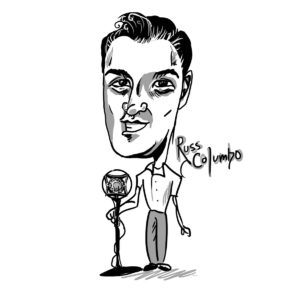
The Non-Crooner
1908-1934
Russ Columbo, the 12th child of Italian immigrants, was primarily a singer, but he was also a violinist and actor—even a composer at times. Some of his songs became famous hits for other legendary performers like Sinatra, Tatum, Bing Crosby, and Lena Horne. He was often compared to Crosby; in fact, many in the business believe that Russ patterned himself after the legendary star. Columbo tried to distance himself from Crosby, stating that he wasn’t a “crooner” (the label often applied to Crosby’s singing style) and put considerable effort into writing and singing songs that he thought would highlight their differences. Columbo debuted as a singer at 13, but even so he would have a very short career due to a very strange accident that took his life when he was only 26 years old. Columbo was in the midst of a widely publicized love affair with Carole Lombard at the time of the accident, which was strongly opposed by Carole’s studio. The complete circumstances surrounding his death remain unclear to this day, but the story is as follows: Columbo was visiting the studio of a friend, and the friend, who was trying to light a cigarette, struck the match on the wooden stock of an antique pistol. The flame set off a charge in the gun, sending a lead ball ricocheting off a table and right into Columbo’s forehead. Even stranger: his mother was very seriously ill at the time and her husband and much of the entertainment world agreed to and successfully pretended that Russ was still alive, even writing her letters and talking about his career until she passed away years later.
Songs from Wake Up and Dream
“My Love”
Unit: Scott Joplin
Scott Joplin
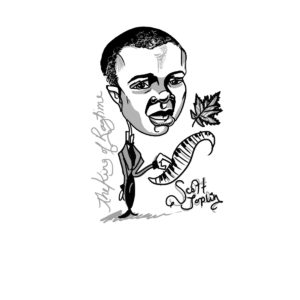
King of Ragtime Writers
1867/68-1917
Scott Joplin is the only performer in this course whose performances we can’t hear. He lived before recording technology was widespread, although we can hear recordings of piano rolls (a roll of paper that operated a piano player) that he made. But while we can enjoy a Joplin performance, his ragtime piano pieces are still widely known even a century after his death.
Joplin was born in Texas in either 1867 or 68 (many people of this time didn’t know their exact date of birth). His father was an ex-slave; he played violin around the house, but he was also absent for long periods of time. Joplin’s mother provided for the family by cleaning homes. She took Scott with her, and when the house had a piano, he would plunk out tunes from church. He began studying with a local German piano instructor who introduced him to European classical music.
Joplin realized he could help the family by playing piano at brothels and dance halls, and performed in Sedalia and St. Louis, MO; he also traveled to Chicago to play during the 1893 World’s Fair. While playing in Sedalia, he met music publisher John Stark, who offered him a music royalty to compose. Joplin composed ragtime music, or rags. They were very syncopated and sounded “ragged” or jerky. Joplin was familiar with the blues, and he combined that sense of syncopation with a European sense of form and harmony, structuring them similarly to military marches. He composed a rag a week and made a living from royalties, teaching, and performing.
Joplin composed until the end of his life, but his mental health deteriorated due to syphilis. He could no longer keep up his piano technique and his memory suffered; he died at age 49 in a state mental institution. Decades after his death, his “Maple Leaf Rag” was still well-known, but it was the 1973 film The Sting, which included several Joplin rags, that renewed popularity and acclaim for Joplin’s music. While he certainly saw success during his own lifetime, he said about his music, “When I’m dead 25 years, people are going to begin to recognize me.”
“Maple Leaf Rag”
“The Entertainer”
https://youtu.be/fPmruHc4S9Q
Unit: Sophie Tucker
Sophie Tucker
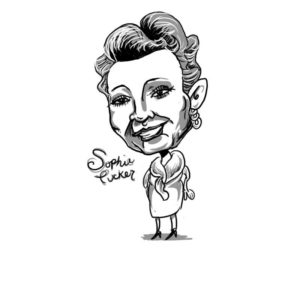
The Last of the Red Hot Mamas
1887-1966
Originally named Sonya Kalish, Sophie Tucker was born in Russia. Her family moved to Connecticut and opened a restaurant, where Sophie sang for tips. As a teenager, she married and had a child, but she was fascinated with performing. She and her husband separated, their child was left with a family member, and Sophie moved to New York to find success as a performer.
Tucker found work performing with Vaudeville. However, producers told her she was “too fat and ugly” to appear as herself on stage. They had her perform in blackface, the practice of white performers trying to look black, or black performers exaggerating the darkness of their skin. It was not until the end of the 1930’s that widespread public opinion recognized blackface as racist. However, after losing her luggage (which included her make-up) on tour, she was allowed to appear as herself. She was a hit and no longer performed in blackface. With her new stage image, she embraced being overweight with humor and innuendo, singing songs like “I Don’t Want to Get Thin” and Nobody Loves a Fat Girl, But Oh How a Fat Girl Can Love.” She said, “Gradually, at the concerts, I began to hear calls for ‘the fat girl.’ Then I would jump up for the piano stool, forgetting about my size, 145 pounds at age 13, and work to get all the laughs I could get.”
In 1911, Tucker made her first recording of the song “Some of These Days,” a hit that became associated with her; she recorded that song several times throughout her career. When Vaudeville waned in popularity, she appeared in radio, television, and film and toured Europe, performing for King George V and Queen Mary in London in 1926. She had her own radio show in the late 1930’s, and appeared numerous times on The Ed Sullivan Show towards the end of her career.
Tucker performed until her 1966 death from lung cancer. She is still remembered for her powerful voice, humor, and boldness.
“I Don’t Want to Get Thin”
“Some of These Days”
Unit: Thomas "Fats" Waller
Thomas “Fats” Waller
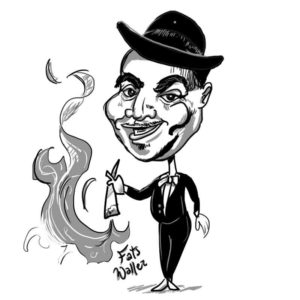
One of the greatest jazz pianists and entertainers
1904-1943
Fats Waller’s original name was Thomas Wright Waller, but he was called “Fats” from an early age. His father Edward was a Harlem lay preacher who wanted his son to pursue a career in the ministry, and Waller played organ for the church as a child. His mother doted on him, but she died when he was a teenager. This was very difficult for him, and he moved in with pianist Russell Brooks and his family. Brooks introduced Waller to James P. Johnson; Johnson, an excellent stride piano player and composer sometimes called “The Father of Stride,” significantly influenced Waller and his music.
Waller performed and recorded extensively in the 1920’s and ‘30s and was one of the most popular musicians of the time. He played and sang as a soloist and with the smaller group Fats Waller And His Rhythm. He was very important as a jazz pianist and was the first prominent jazz organist. Songwriting came very easily to him; bandleader Fletcher Henderson once treated Waller to lunch, offering to buy him a hamburger in exchange for a song. Fats wrote ten songs for ten hamburgers. Waller’s showmanship often overshadowed his talent. His talking during the end of a recording became something of trademark, and exaggerated facial expressions during performances amused audiences.
Unfortunately, Waller was bad with money—he spent some time in jail for not paying alimony—and he had a drinking and eating problem. The combination of an unhealthy lifestyle, legal stress, and a heavy touring schedule hurt his health, and he died of pneumonia while traveling.
Two of Waller’s best-known songs, “Ain’t Misbehavin’” and “Honeysuckle Rose,” were inducted into the Grammy Hall of Fame. He said about music: “You get that right tickin’ rhythm, man, and it’s on!”
“Ain’t Misbehavin’”
“Honeysuckle Rose”
Unit: Jelly Roll Morton
Jelly Roll Morton
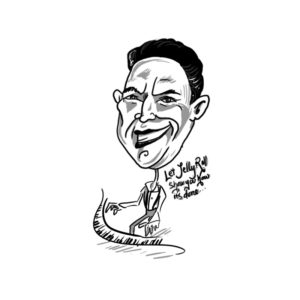
1885-1941
The Creator of Jazz
Jelly Roll Morton (birth name Ferdinand Joseph Lamothe) was one of the first jazz soloists, and many consider him to be the first great jazz composer.
He was born in 1885 in New Orleans, and his grandmother raised him in a well-to-do Creole household. He received a quality education, which included piano instruction, studying European classical music, and listening to French opera. By the age of thirteen, he was a great piano player and realized he could make hundreds of dollars a night playing piano in the brothels of New Orleans. His grandmother kicked him out of the house when she found out, and he proceeded to gig throughout North America, from New Orleans to St. Louis, Las Vegas, Los Angeles, Vancouver, Chicago, New York, and back to New Orleans. He recorded some influential albums, particularly with his group The Red Hot Peppers. These recordings set a standard in jazz where a small group plays both as an ensemble and where each member is a highlighted soloist, and blended concepts of composition (working with already existing music) and improvisation (creating music on the spot). Additionally, Morton played with a sense of swing that future musicians emulated.
Jelly Roll Morton developed a national presence and made good money. He didn’t take care of his fortunes, but he loved to show it off with extravagant suits and cars, and having a diamond embedded into one of his teeth. He had a way of upsetting musicians; he would go to music clubs, listen to a pianist, and then tell the pianist to move so that Jelly Roll could demonstrate how it’s really done. He also insisted to have created jazz: “It is evidently known, beyond contradiction, that New Orleans is the cradle of Jazz and I, myself, happened to be the creator in the year 1902.” About the genre, he said, “Jazz music is to be played sweet, soft, plenty rhythm.”
Jelly Roll Morton died prematurely. He was stabbed in a Washington, D.C club and never fully recovered from his injuries. He suffered breathing problems the rest of his life before passing away in 1941. While he was still alive, he was recorded in a series of interviews where he chronicled his music, and these recordings are preserved in the Library of Congress.
Unit: Frank Sinatra
Frank Sinatra
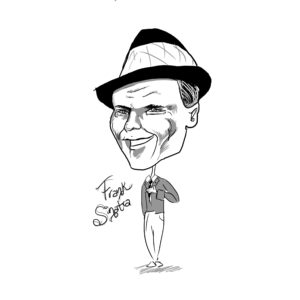
1915-1998
Leader of the Rat Pack
Frank Sinatra, one of the most popular singers of the twentieth century, was born in New Jersey in 1915 to Sicilian immigrants. Bing Crosby’s singing greatly influenced Sinatra, and Sinatra dropped out of high school to become a singer. His first big break came with the Major Bowes Amateur Hour, a show where performers competed for a prize and the chance to perform with Major Bowes throughout the country. He also found work singing for radio shows before even bigger breaks singing with the Harry James and Tommy Dorsey big bands; this was the era of swing, and Sinatra, who started as a crooner (an emotional singer), developed an energy, a sense of swing, a swagger while performing.
In 1943, Sinatra signed with Columbia Records as a solo performer. By this time, a series of successful concerts started Sinatramania; teenage girls were obsessed with the singer portrayed as the shy, Italian-American kid who made it big. He had a string of hits, was performing up to 45 times a week, and starred in films. But by the late 1940’s, his career slumped. His image suffered with news of his affair with Ava Gardner and the end of his first marriage, and he sporadically suffered from voice problems. But these setbacks set up one of the greatest comebacks in show business history. He relentlessly lobbied for a role in the film From Here to Eternity, a role which earned him an academy award for Best Supporting Actor. This sparked non-stop recording, performing, and acting. He was no longer the shy, swooning kid, but rather the brassy swinger. He said of himself: “I’m not one of those complicated, mixed-up cats. I’m not looking for the secret to life… I just go on from day to day, taking what comes.” He was leader of the Rat Pack, a group of performers in the 1950’s and 60’s who included – among many others – Dean Martin, Sammy Davis, Jr., Judy Garland, and Shirley MacLaine.
Sinatra was a perfectionist; while still developing his breathe control, he studied how Tommy Dorsey breathed while playing trombone, and he would practice staying underwater to increase his lung capacity. He is remembered as one of the most captivating performers of the twentieth century, with an impressive vocal range and an energy that was contagious to everyone he played with. He turned lyrics into sung stories, and the songs he sang became a major part of the American songbook.
“Come Fly With Me”
https://www.youtube.com/watch?v=HmQq6yLe2ww
“My Way”
https://www.youtube.com/watch?v=6E2hYDIFDIU

